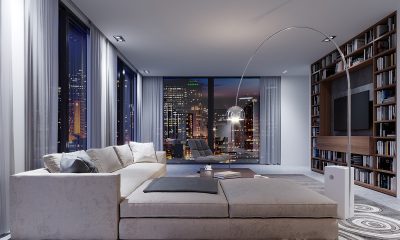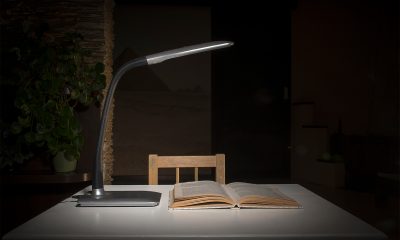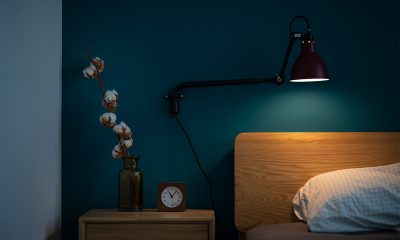What are study lamps
Study lamps are meant to deliver localized lighting that enables a user to perform reading and writing tasks effectively and comfortably. These lights are developed primarily for students who are tasked with sustained visual works. Lighting may enhance or degrade task performance. As a fundamental component of a layered lighting design, localized task lighting provided by desk lamps must supply the right amount of illuminance and sufficient coverage of the task area for users to accomplish visual tasks at the desired speed and accuracy. At the same time, it should not constitute a source of discomfort, distraction and health risk.
The quantity of light is just one aspect of lighting. It is essential to consider the quality of light which can be influenced by various interdependent factors such as luminance, light distribution, color characteristics, and modulation or the variation in intensity of a light source with time. The object of task lighting must be considered beyond the standard quality characteristics for illumination. In addition to addressing visual needs, lighting can positively or negatively stimulate non-visual effects on human psychology and physiology, and awareness of photobiological hazards associated with artificial lighting should be a key consideration that goes into the design of study lamps.

Study lamps are now a realm of LED lighting
LED lighting has become a ubiquitous technology platform that enables today’s task lighting products to deliver profound performance, design, application and economic benefits. The technology makes all qualitative and quantitative aspects of lighting fully controllable, which offers the opportunity to improve the visual performance of lighting while simultaneously providing tremendous energy savings over a significantly extended period of service life. Through package-level phosphor conversion or module-level color mixing, the spectral power distribution (SPD) can be engineered to deliver an optimum spectrum for the function of the light.
The spectral composition can be prescribed to enable high color rendering lighting and engage specific physiological and psychological responses that support a specific activity. The full, instantaneous dimmability and robust on/off switching performance of LEDs provide the ability to deliver the right amount of light on demand, allowing lighting to be finely tuned to suit personal preferences and the nature of the tasks performed. The small source size and optical directionality enable full control over the optical distribution and provide an infinite variety of design possibilities that allow form and function to comingle in desk lamps.
Design and construction of LED desk lamps
LED desk lamps may come in a lamp-plus-fixture configuration but are more often designed as integrated systems in which an assembly of LED packages (LED module) becomes a luminaire-level building block. The integrated design is inherently superior to the bulb-based configuration because it can effectively address the operational complexity of LEDs. In LED bulbs, physical constraints to heat sink and driver circuitry design lead to a shortened product life. The bulky volume and omni-directional light distribution of light bulbs become design encumbrances.
Integrated LED desk lamps have a short, high efficiency thermal path made possible by stripping off superfluous elements that come with the use of light bulbs. The LED module is attached to the heat sink. The use of the metal core printed circuit board (MCPCB) where the LEDs are mounted, and sometimes a thermal interface material (TIM), allows thermal resistance between the LED packages and heat sink to be reduced to a minimum. The housing and heat sink are often formed as one piece, which maximizes the effective surface area for thermal convection. Effective thermal management contributes to excellent lumen maintenance and high color stability.
The LED driver may be incorporated into the lamp head or mounted elsewhere in the luminaire. Custom designed LED optics produce highly efficient and precisely controlled optical distributions while aesthetically enhancing the design language of the task light. The lamp head is usually adjustably mounted to a supporting arm. The flexibility of optical aiming and lamp head positioning can be reinforced using a fully adjustable gooseneck arm or counter-balanced articulating arm. The stability of the desk lamp is provided by the base or clamp.
Optical system
A key product differentiator for LED study lamps is optical design. Task lighting should support visual needs by providing users a comfortable, pleasant and high visibility environment. Generally, this means both luminance and illuminance need to be carefully controlled. The goal of optical design is to direct luminous flux emitted by the LEDs into desirable luminous zones while eliminating excessive luminances and high contrasts that can either lead to visual fatigue or become uncomfortable sources of glare.
The optical characteristics of LEDs impose a great challenge on optical design. LEDs are very high flux intensity emitters that produce a large amount of lumens from a small emitting surface, which causes the luminance of an individual LED to easily exceed 1,000,000 cd/m2. Since desk lamps are placed in close proximity to the task surfaces, direct view of the LEDs may cause a reduction in visibility (disability glare) or feelings of discomfort (discomfort glare). Extended direct exposure to high intensity LEDs can potentially lead to retinal damage. Uniform lighting throughout the task area is just as import. Large luminance variations across the task area cause our eyes to frequently adjust to different light level, which can be visually fatiguing and affect task performance.
The challenging optical design requirement is generally addressed using direct diffusion or edge-lit technology. Direct diffusion refers to the use of opal diffusers to diffuse luminous flux from LEDs evenly to all directions thus does not create excessively high luminance. Edge-lit LED desk lamps make use of a light guide to extract light emitted by side-emitting LEDs through total internal reflection (TIR) and then refracts the light uniformly towards an opal diffuser. Soft, homogeneous illumination can be achieved with this optical architecture.
Color rendering
A spectral power distribution describes the right amount of radiant energy emitted by a light source at the different wavelengths of the visible spectrum. How object colors are rendered depends on wavelength distribution of the light. Rendering reading materials in a natural fashion contributes to greater visual comfort and is essential when the task is color sensitive. A color rendering index (CRI) of 85 is often considered the minimum acceptable value for task lighting applications. A high CRI does not necessarily mean that all the rendered colors will be accurate. The CRI calculation is based on only eight of the 14 reflective samples (Ra) and does not take into consideration the spectral reflectances of highly saturated colors.
Faithful color reproduction calls for a spectrum having the right amount of spectral content at each wavelength. This usually translates to a minimum CRI of 90 and high special color rendering indices, referred to as R9 through R14. R9, the fidelity metric for saturated red, is often listed individually as an important indicator of the color rendering ability of LEDs. An R9 value of 25 is good, and R9 values above 50 should be prescribed for color-critical, detail-intensive tasks.
Color temperature
The spectral characteristics of a light source also determine how the light appears and can be indicated by the correlated color temperature (CCT). Different white chromaticities, such as warm white, neutral white and cool white are a function of the percentage ratio between the amounts of energy distributed in blue and red portions or the visible spectrum. Blue-enriched white light has a noticeably “cool” appearance. Red-saturated white light appears warm.
In general, a spectral composition with a balanced ratio between blue and red is recommended for task lighting. The resulting color is a neutral white exhibiting a CCT in the range of 3500K to 4100K. Light emitted by a neutral white source contains a decent amount of blue that promotes concentration and supports mental acuity, while an equal amount of red light imparts a feeling of comfort that helps reduce fatigue. For those who prefer the feeling of mid-day brightness, a light source with a CCT of up to 5000K can be used.
Task lighting in CCTs exceeding 5000K is not recommended because blue light is a potent suppressor of pineal melatonin. Excessive exposure to blue light during the night puts the users at a higher risk for disruption of the circadian rhythm. Over long periods of circadian disruption there can be adverse health effects. Task lighting must satisfy a variety of human needs, among which include physiological and psychological needs and personal preferences for the color appearance of a white light source. A study lamp may be designed to emit in multiple CCT options or simply incorporates a tunable white LED light engine that provides the flexibility to change the color of light from warm to neutral to cool in appearance.

Photobiological safety (blue light hazard)
Photobiological safety with LED lighting has been rigorously debated. The use of LED study lamps is of particular concern because these task lights provide close-range lighting and many of the users are young children. The risk of blue light hazard (BLH), a photochemical damage to the retina, is often associated with LEDs. Most white LEDs are blue-pump packages in which only part of the blue light emitted by a semiconductor chip is phosphor-converted to longer wavelength light. The resulting blue peak in LED SPDs can be easily misinterpreted as suggesting an abnormally high blue content.
However, the spectral peak does not correlate to the total amount of photochemically hazardous blue light, which must be calculated over a range of wavelengths (400-500 nm). The percentage of blue light in the spectrum is typically not higher for blue-pump LEDs than it is for any other light source at the same CCT. Regardless of the types of light source, the contributing factors to blue light hazard are direction, duration, intensity, and spectrum.
When designing an LED task light, caution should be exercised on glare control and CCT selection. LED lighting can lead to retinal exposure of an excessive amount of blue light if the high LED luminance is not sufficiently minimized or the high intensity LEDs are not properly shielded from direct view.
The importance of good optical design cannot be overemphasized. LEDs can inherently be designed to perform as Risk Group 0 products that pose no photobiological hazard. Only those with no adequate optical shielding and diffusion may fall into Risk Group 1 (no photobiological hazard under normal behavioral limitations) or 2 (does not pose a hazard due to aversion response to bright light or thermal discomfort).
The higher the CCT, the higher the proportion of blue photons emitted by a white light source. There’s no earthly reason to use excessively high CCT (daylight white) LEDs for task lighting.
Flicker mitigation
Another critical aspect to consider is LED drive current regulation. LEDs operate on direct current (DC) and are sensitive to current and voltage fluctuations. Failure to deliver tightly regulated driver current may cause objectionable visual effects. To operate on AC mains power, the LED driver needs first an alternating current to a direct current. The rectified DC power is then converted into voltages and currents compatible with the LED packages typically through a switched-mode power supply (SMPS).
Incomplete suppression of the sinusoidal waveform of the alternating mains voltage after rectification leads to generation of residual ripple that is responsible for light flicker at a repetition rate of twice the AC sinusoidal frequency. LEDs can reproduce the alternating current waveform faithfully to produce visible or invisible flicker depending on the frequency. Low-frequency flicker that is visible to the human eye is usually not present in most LED products. However, even if it is not visible, high-frequency flick can induce eyestrain and fatigue and affect one’s ability to concentrate. Longer term exposure to high frequency flicker can cause negative health effects such as headaches or even seizures in small percentage of the population. Higher frequency flicker is often created by the DC-DC converter architecture.
To stay safe and avoid discomfort, the current ripple in the driver output should be reduced to a relatively low value (±5% max.). The LED driver also determines the controllability of a task light. Multilevel switching or continuous dimming circuitry is often built into the driver to support visual needs and energy management. Flicker control should be exercised as well when implementing pulse width modulation (PWM) dimming.
OLED lighting
Despite its cost and efficacy disadvantages, OLED lighting deserves to be mentioned when it comes to close-range task lighting. OLEDs are surface-emitting devices that naturally diffuse a soft, pleasant and homogeneous light over a task plane. The white light emitted by OLEDs is composed by mixing three primary colors (red, green, and blue) of light. The color mixing method enables more uniform distribution of radiant energy throughout the visible spectrum. The balanced spectrum allows OLEDs to perform superbly in color reproduction.
An OLED consists of a stack of organic layers sandwiched between two planar electrodes. These organic layers have optimized to provide different functionalities like charge injection, charge transport and light emission. OLEDs have electrical characteristics similar to their inorganic cousins. They must be driven with a constant current. The driver should provide tight load regulation in order to achieve flicker-free lighting and the expected service life.


















Loading...